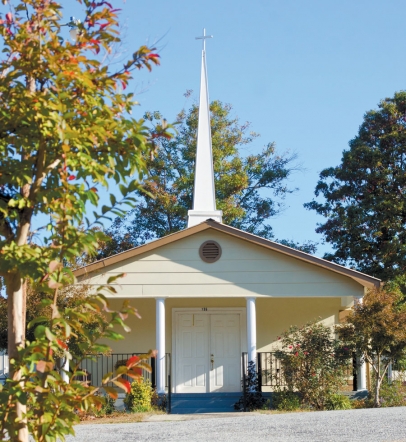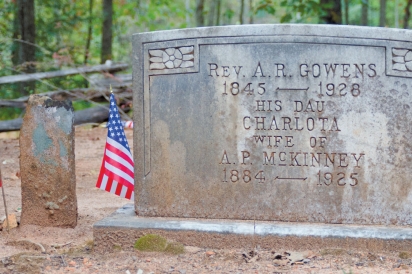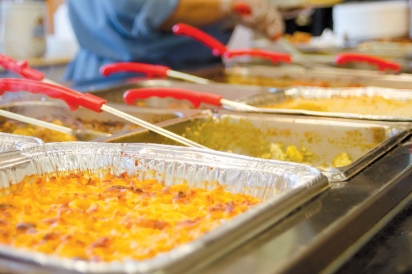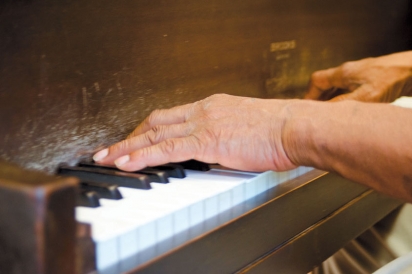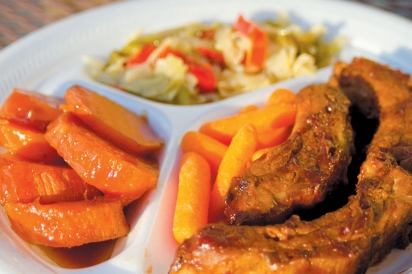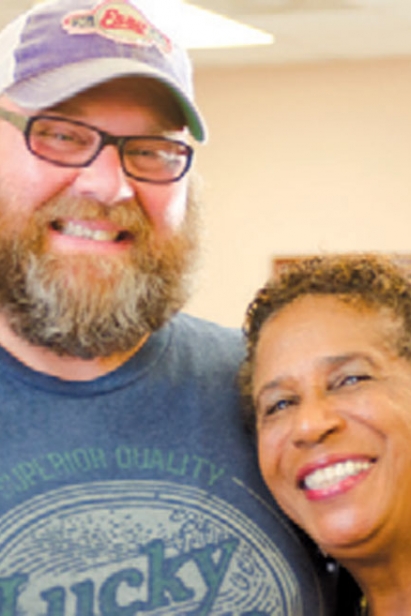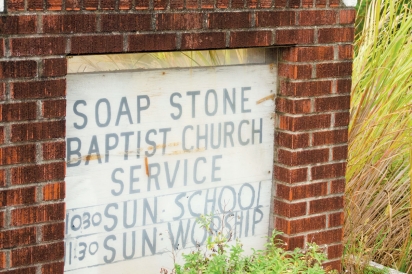Food with a Higher Calling
Keeping a promise made to her mother, Mable Owens Clarke cooks to fund this historic church property.
I first encountered Ms. Mabel Owens Clarke in spring 2011. At the time, I was a marketing director for Clemson University, and a student anthropology group was working on a project with anthropology professor Mike Coggeshall. It was my job to promote their work and attract local and national news to take interest in the project.
Simple: show up at Soapstone Baptist Church, the first African American church in the Upstate, in a place called Liberia, SC; talk with students and community members about the project; write a few articles; snap a few photos; assist in a video shoot—the typical marketing stuff.
Only this project wasn’t typical, and what I encountered that morning moved me in ways that have stuck with me since.
There’s a special energy at Soapstone you can feel while wandering the property. Some say it’s the spirit of the Native Americans who once carved bowls and other items from the indigenous soapstone croppings. Some say it’s the spirit of those freed slaves who founded Liberia and made what many saw as a meager and fallow land prosperous. Some say it’s nothing less than the spirit of God. Recent visitors attribute it to the heart of Ms. Mabel herself, the joy and commitment she exudes while keeping the promise she made to her mother on her deathbed: to maintain the land and church for posterity.
A Bit of History
Roughly 130 years ago, 900 freed slaves settled the area called Little Liberia in Pickens County, named after the original African nation. Their former masters settled along prime farmland near the main towns and roads and gave the former slaves the more “undesirable” land in the outlying areas. But the Liberians went to work making the land plentiful and building a rich community.
Mabel Clarke is the last living descendant of the original Liberia families. Her great-grandfather Joseph McJunkin founded Soapstone Baptist Church, and her parents, who both lived for more than 100 years, are buried in the churchyard.
A one-room schoolhouse, thought to be the oldest African American school in South Carolina, stands beside the church. Ms. Mabel attended until fifth grade when the county started bussing local children to an Easley school (segregation was very much alive, and Ms. Mabel once told me that she passed three white schools on the way to the black school in the city).
In the 1960s, the KKK burned the original church to the ground. But the community came together, and through the help of other churches and local volunteers, they rebuilt Soapstone into the small yet mighty structure it is today.
Community came together again in 2011, when professor Mike Coggeshall, along with professors Melissa Vogel and Katy Weisensee, volunteered themselves and a group of anthropology students to help clean, map, and begin documenting a recently unearthed slave cemetery, located just down from the church and schoolhouse.
While Ms. Mabel and others had heard of its existence, the cemetery’s location was a mystery until a surveyor noticed the small soapstone grave markers hidden beneath brush, trees, and natural overgrowth. This revelation made Ms. Mabel’s commitment to maintain Soapstone even more urgent. “I really just want to give those slaves the dignity they so well deserve. So, any light that can be shined on the cemetery… I can see those people in those graves just smiling and saying, ‘thank you,’” she once told me.
The Soapstone property, including the church, graveyard, one-room schoolhouse, and slave cemetery, perches on a ridge with commanding views of the surrounding valley. If you stand atop the large soapstone cropping adjacent to the church, you see Table Rock in the near distance, as well as the Blue Ridge Mountains, which on some days appear as a foggy indigo wall. It’s hard to imagine anyone once thought this land undesirable.
Fish Frys
While the term “fish fry” connotes fried fish and the fixings, Ms. Mabel and a hoard of volunteers offer so much more than that. “I peeled 80 pounds of potatoes this morning at 4 a.m.,” Ms. Mabel tells me on my most recent visit. “I sure could use some help with chopping collards,” she adds, laughing.
Indeed, Soapstone’s fellowship hall has 15 round, 6-person tables, and the monthly fish fry runs from noon to 7 pm. That’s an awful lot people and an awful lot of food. On our most recent visit at 3 pm., we thought we would avoid the rush, but it was packed. And that’s a great thing, since Ms. Mabel runs the fish fry to financially support the church in the most basic of ways.
If you like soul food, meat-and-threes, the kind of Southern cuisine your grandmother made—then the monthly fish fry is your mecca. Fried fish and chicken, Ms. Mabel’s signature sweet and sour cranberry chicken, smoked ribs, broccoli casserole, squash casserole, rice and gravy, black eye peas, green beans, candied sweet potatoes, creamed corn (Ms. Mabel literally “milks” the corn), collards, roasted potatoes, and everyone’s favorite “vegetable,” macaroni and cheese. And more. Yes, even more. And homemade desserts: cheesecake, peach cobbler, and apple pie. And yeast rolls, cornbread, and sweet tea and lemonade. Seriously, the list never ends.
As one happy visitor told me between bites, “You can taste the love.”
Standing in line (yes, it’s that good), I realized that two people ahead of us stood none other than Mike Coggeshall and his wife. Imagine that—the man who first brought me to this sacred place, standing in line, just ahead of me, waiting for Ms. Mabel’s food.
Kismet. Shared space. Community.
Just as the Liberia community came together to rebuild the church after it burned down in the 1960s, the community comes together to support Ms. Mabel’s mission. She is a most beloved figure here. Even though she’s been prepping and cooking for days, she walks around the room, table to table, greeting guests—some regulars and some folks who maybe just heard about this extraordinary gathering and came to check it out for the first time. She’s never short on a smile and a hug, and before you leave, you consider joining the church, no matter if you already belong somewhere else and even if you aren’t Baptist.
Today
A lot has happened since I first met Ms. Mabel. The Soapstone site is now a valued part of the S.C. National Heritage Corridor and is visited by locals and tourists alike. The church and Ms. Mabel have been featured in numerous articles, interviews, and stories. The University of North Carolina Press plans to publish Coggeshall’s book on Liberia in early spring. An oral history of the place has been documented, as have student videos about Soapstone. An educational kiosk provides a bit of history about the site and cemetery. Once overgrown and virtually forgotten, a pristine fenced cemetery provides the departed a place to truly rest. Tiny American flags decorate each grave.
But one thing hasn’t changed: underfoot, the land pulses with an energy that I’ve never encountered anywhere else. You can feel the history here: the pain, the toil, the joy. You can feel the ancestors guiding your visit to a certain sense of peace that words just can’t describe. It must be felt, and to do that, you must go and walk the land, pay respect to those departed souls, and stand on the soapstone cropping.
And the best time to do this is on the third Saturday of every month (with the exception of December), when the aromas of yeast rolls and fried chicken, the punchy fragrance of collards and broccoli casserole permeate the air as soon as you turn onto Liberia Road and head up the hill to the church. You know you’re at the right place because you can smell its goodness.
Once inside, you’re treated to rollicking good music from church musician (and locally-dubbed historian) Mr. Roosevelt Aiken, who has played with the likes of Charley Pride and Chocolate Thunder. In between tickling the ivories in a corner of the fellowship hall, Aiken leads cemetery tours, educating visitors to the history and importance of Soapstone… because Ms. Mabel’s mission now goes beyond just maintaining Soapstone.
She wants everyone to have a seat at the table, to learn about the history of this place and its people. Because the community’s history is a shared history. And once you’ve stepped inside, you become part of Ms. Mabel’s extended family, part of her ministry to tell the story of this place so it’s honored and never forgotten.
And it’s the food that gets us there.


